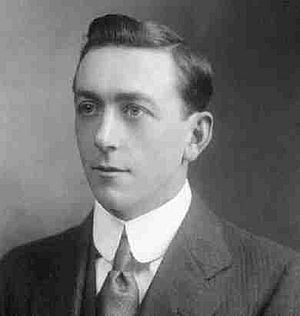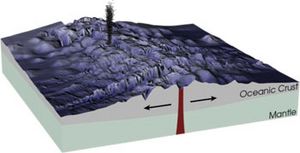Arthur Holmes facts for kids
Quick facts for kids
Arthur Holmes
FRS FRSE
|
|
|---|---|

Holmes around age 22
|
|
| Born | 14 January 1890 Hebburn, England
|
| Died | 20 September 1965 (aged 75) London, England
|
| Alma mater | Imperial College London |
| Awards | Murchison Medal (1940) FRS (1942) Wollaston Medal (1956) Penrose Medal (1956) Vetlesen Prize (1964) |
| Scientific career | |
| Institutions |
|
| Influences | Robert Strutt |
Arthur Holmes (born January 14, 1890 – died September 20, 1965) was an important English geologist. He helped us understand the Earth much better. He was one of the first to use a method called radiometric dating to figure out the age of rocks. He also understood how the Earth's inside layers move, which later helped explain plate tectonics.
Contents
Arthur Holmes's Life Story
Arthur Holmes was born in Hebburn, England, near Newcastle upon Tyne. His father, David Holmes, was a cabinet-maker.
When he was a child, Arthur lived in Low Fell, Gateshead. He went to Gateshead Higher Grade School. At 17, he started studying physics at the Royal College of Science (now Imperial College London). But in his second year, he took a geology class and loved it! This decided his future, even though his teachers advised him to stick with physics.
It was hard for him to live on his scholarship money, which was £60 a year. After graduating, he got a job looking for minerals in Mozambique. After six months, he hadn't found anything and became very sick with malaria. People back home even heard that he had died! Luckily, he got better and was able to travel back to England. He then became a teacher's assistant at Imperial College.
Arthur earned his highest science degree in 1917. In 1920, he joined an oil company in Myanmar as their main geologist. But the company didn't do well, and he returned to England in 1924 with no money. Sadly, his three-year-old son became ill and passed away shortly before Arthur left Myanmar.
From 1924 to 1943, he was the head of the Geology Department at Durham University. Then, from 1943 to 1956, he held the top geology position at the University of Edinburgh.
Arthur Holmes passed away in London on September 20, 1965, when he was 75 years old.
Arthur Holmes's Family Life
Arthur Holmes married his first wife, Margaret Howe, in 1914. She passed away in 1938. The next year, Arthur married Doris Reynolds, who was also a geologist and taught at Durham University. After Arthur died, Doris helped publish the third edition of his famous book, Principles of Physical Geology.
How Arthur Holmes Figured Out the Earth's Age
Arthur Holmes was a pioneer in geochronology. This is the science of figuring out the age of rocks and the Earth. While he was still a student in London, he performed the first accurate radiometric dating using uranium and lead. This method measures how old a rock is by looking at radioactive elements inside it.
In 1911, he published his findings, saying a rock from Norway was 370 million years old. This was a big improvement on earlier work. In 1912, while working at Imperial College, he published his famous book, The Age of the Earth. In this book, he strongly argued that radioactive methods were the best way to find the Earth's age. Many people at the time still believed Lord Kelvin's idea that the Earth was less than 100 million years old.
Holmes estimated that the oldest Archaean rocks were 1,600 million years old. However, he didn't guess the exact age of the Earth yet. By this time, scientists had discovered isotopes, which made the calculations more complex. He spent many years working through these challenges. Because of his efforts to promote this theory, he became known as the Father of modern geochronology.
By 1927, he had updated his estimate for the Earth's age to 3,000 million years. In the 1940s, he refined it further to 4,500 ± 100 million years. This was based on new measurements of uranium isotopes. The method he developed is now called the Holmes-Houterman model.
In 1924, he became a "reader" (a type of professor) in geology at Durham University. His hard work was recognized in 1942 when he became a Fellow of the Royal Society. The next year, he became the head of geology at the University of Edinburgh, a position he held until he retired in 1956. In 1944, he published the first edition of his book Principles of Physical Geology, which became a very important textbook.
Arthur Holmes and Continental Drift
Arthur Holmes was a strong supporter of the continental drift theory, which was first suggested by Alfred Wegener. At the time, many other scientists didn't believe in it. One big question was: how do continents move?
Holmes suggested that the Earth's mantle (the layer beneath the crust) has giant "convection cells." Think of it like boiling water in a pot: hot material rises, cools, and then sinks, creating a circular flow. Holmes believed these slow-moving currents in the mantle were caused by heat from radioactive elements. He thought these currents were strong enough to move the Earth's crust on the surface. This idea helped explain how seafloor spreading happens, where new ocean floor is created at mid-ocean ridges. His book Principles of Physical Geology even ended with a chapter about continental drift.
Awards and Honors for Arthur Holmes
Arthur Holmes received many important awards for his work, including:
- 1940: Murchison Medal from the Geological Society of London
- 1946: Sederholm Medal from the Geological Society of Finland
- 1955: Foreign Member of the Académie des sciences in France
- 1956: Penrose Medal from the Geological Society of America
- 1956: Wollaston Medal from the Geological Society of London
- 1962: Makdougall Brisbane Medal from the Royal Society of Edinburgh
- 1964: Vetlesen Prize from Columbia University
The Arthur Holmes Medal (given by the European Geosciences Union) and a crater on Mars are named in his honor. The Isotope Geology Laboratory at Durham University's Earth Sciences Department is also named after him, as is the students' Geology Society there.
Arthur Holmes's Main Books and Papers
- The age of the earth (1913, with later editions in 1927 and 1937)
- The nomenclature of petrology, with references to selected literature (1920, 2nd edition 1928)
- Petrographic methods and calculations with some examples of results achieved (1921, 2nd edition 1930)
- Radioactivity and Earth Movements (1931)
- Principles of Physical Geology (1944, with later editions in 1965, 1978, and 1993)
- The Phanerozoic time-scale; a symposium dedicated to Professor Arthur Holmes (1964)
See also
 In Spanish: Arthur Holmes para niños
In Spanish: Arthur Holmes para niños


